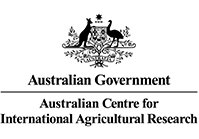
Pacific Pests, Pathogens & Weeds - Mini Fact Sheet Edition
Cowpea aphid (356)

Summary
- Worldwide distribution. Common among Pacific island coutries on food legumes.
- Nymphs slate grey, adults shiny brown or black. In tropics, young born alive. Overcrowding produces winged adults. Spread on the wing and on wind currents.
- Damage severe if infestations early: i) directly by sap-sucking adults and nymphs damaging shoots, pods and causing stunting (toxins are produced) or wilting, or ii) indirectly spreading (more than 30) viruses and production of honeydew attracting sooty moulds.
- Natural enemies: ladybird beetles, lacewings, hoverflies; parasitoid wasps, e.g., Trioxys indicus.
- Cultural control: avoid planting next to, or down-wind from infested crops; weed (especially wild legume hosts); remove infested leaves; destroy ant colonies with boiling water (or insecticides); collect and destroy debris after harvest.
- Chemical control: i) PDPs (derris, chilli, garlic, neem, pyrethrum); ii) soap solution, horticultural or white oils (see Fact Sheet no. 56). Preserve natural enemies, avoid broad-spectum insecticides. Only use e.g., synthetic pyrethroids to kill ants.
Common Name
Cowpea aphid, groundnut aphid, bean aphid, black legume aphid.
Scientific Name
Aphis craccivora
AUTHOR Grahame Jackson
Information from CABI Aphis craccivora (groundnut aphid) (2017) Crop Protection Compendium. (www.cabi.org/cpc); and Aphis craccivora Wikipedia. (https://en.wikipedia.org/wiki/Aphis_craccivora); and from Godfrey LD, et al. (2017) Alfalfa Cowpea Aphid UC/IPM. Agriculture & Natural Resources, University of California. (http://ipm.ucanr.edu/PMG/r1301511.html). Photo1 Mani Mua, SPC, Sigatoka Research Station, Fiji. Photo 2 Whitney Cranshaw, Colorado State University, Bugwood.org.
Produced with support from the Australian Centre for International Agricultural Research under project HORT/2016/185: Responding to emerging pest and disease threats to horticulture in the Pacific islands, implemented by the University of Queensland and the Secretariat of the Pacific Community.
This mini fact sheet is a part of the app Pacific Pests, Pathogens & Weeds
The mobile application is available from the Google Play Store and Apple iTunes.




Copyright © 2020. All rights reserved.
 Pacific Pests, Pathogens & Weeds - Mini Fact Sheet Edition
Pacific Pests, Pathogens & Weeds - Mini Fact Sheet Edition